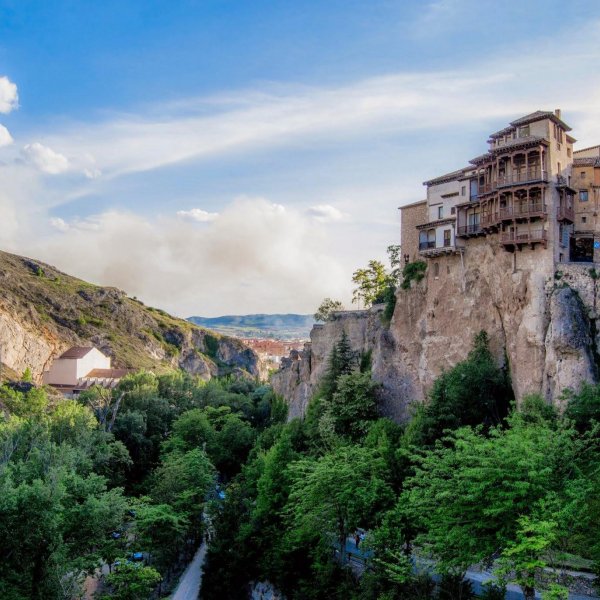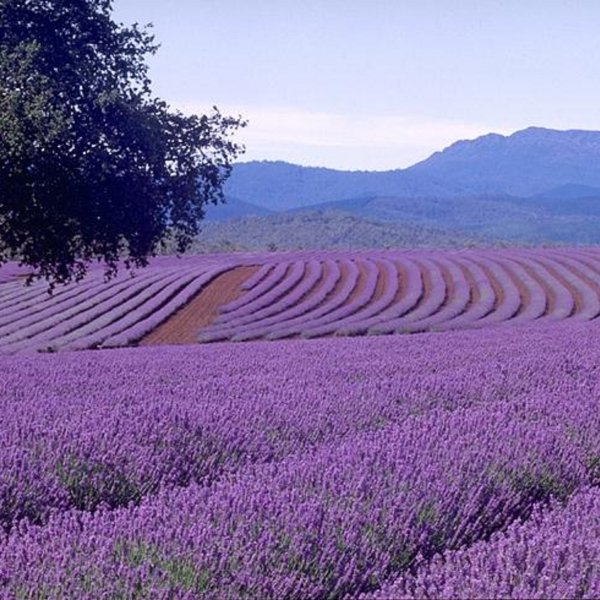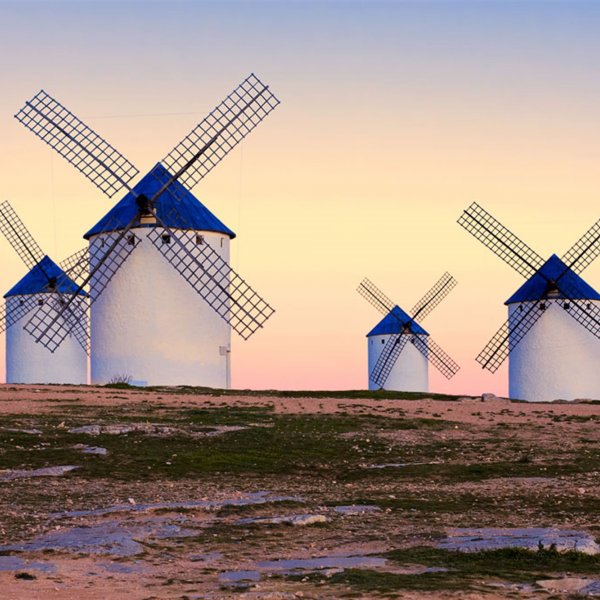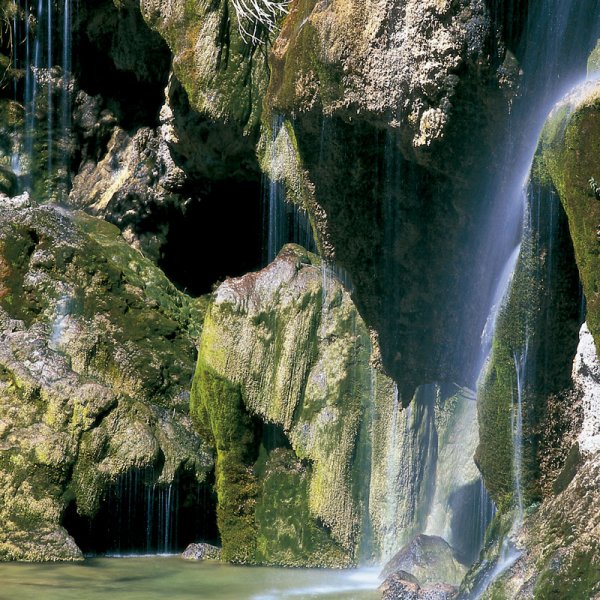- Home
- Destinations
Land of mills and a gentleman Hidalgo called Don Quixote of la Mancha
Discover with us everything that Castilla la Mancha has to offer. Nature, wildlife, gastronomy, villages and citys… dream places.

Cuenca
The city of Cueca, declared Patrimony of Humanity by the UNESCO, is one of the cities with a material and immaterial wealth of Spain.
Cuenca is landscape city raised on a tongue of land between the sickles of the Júcar and Huécar rivers, which gave a natural incomparable frame to a urbanism anchored in time. These sickles keep locked up a huge historic patrimony that sits between two cliffs, and immersed a city in nature by thousands of years on geological morphology, little by little pierced by these rivers and which it forms a stone structure that dwarfs the one who looks at them.
La Cuenca is a patrimony city that opens to the visitant as a perfect fusion between modern art and tradition, is essential for the traveler to walk the old town, letting get loose for the charming framework streets that came with important samples of religious patrimony as churches, convents, seminaries which you can breathe the entrenched cult tradition of the city, even important museums as the Abstract Art Museum, the Antonio Perez Foundation or the Secret Museum of the cathedral, good example of provincial sacred art were important works are guarded from the Romanic to the actuality, highlighting the art picture of Martin Gomez el Viejo and El Greco. A city of contrasts where the modern and traditional coexist.
The most impressive building in the city, the Cathedral de Nuestra Señora de Gracia, the first of Gotic in Spain was built by the order of Alfonso VII. His wife, Leonor of Aquitaine and Plantagenet, sister of Richard Lionheart, introduces the gothic aires in the cathedral Factory which is considered as the first gothic cathedral of Castilla, being consecrated in 1208 under the patronage of Santa Maria. On the inside, the light effect gets through the stained glass, which it takes the visitant to a mistic walk that does not stop surprising while watching the construction from the XII century to the last Baroque chapel.
The Cathedral visit gets complemented with an impressive view on heights from the Triforium of the Cuenca Cathedral. A small spiral staircase leads the visitor to the cathedral sky. From there we are received for the impressive views of the Cathedral, a singular spectacle that allowed us to appreciate every detail, every corner. Since there, to the exterior will surprise you the main square from the heights, where we can appreciate not just the most of the characteristic buildings of the Old Town also a panoramic view of New City and the Sickle of Jucar, with its impressive reliefs and natural landscapes.
The Treasure Cathedral Museum of Cuenca, designed by the artist Gustave Torner, exhibits more than 200 pieces of great value and singularity, especially in the referred ones to the XVI century. Dedicated rooms to medieval art, the renaissance, and the vault treasure, where also of the craftwork we can find two wonderful works of El Greco, as the Diptico Bizantino Reliquary Icon of the Epiro despots, and a big collection of pencils and carpets.
Of the hanging Cuenca, all the world knows its Hanging Houses, an example of popular Conquense architecture where its balconies invite you to observe the emptiness converting in saint and sign of the city, As its skyscrapers of San Martin, the first buildings with more than 10 floors of the world.
The San Pablo bridge, designed by the Eiffel school, its converts in a walk for the audacious and an adventure for the vertiginous but lets everyone with the same sensation of sitting in one of the best places of the city. The sensation that produces sitting on el Barrio del Castillo where the visitant can feel the city at his feets, because its lookouts appear at the most unheard-of depth.
Inside of the emblematic Hanging Houses, we can find with one of the artistic samples more significative of art in Spain from the XX midcentury: The Abstract Art Museum. The museum exhibits more than a hundred of painting and sculptures, one of the more complete collections of Spanish artists works of the abstract generation of the fifties and sixties, continuation, in a certain way of the renovating ideas that one had had Picasso, Miro, and Gris. In there are represented artists like Canogar, Chillida, Feito, Millares, Oteiza, Tapies, Torner, Zobel.
We cannot forget about the Cuenca Savor, this city is also formed by its singular flavors, its succulent meals, and typical dishes. Is an obligation not leaving without trying their mortar, their garlic grill, porridge or a roast of lamb, and dare - without knowing what it is before - to eat a zarajo, all accompanied by the wines of the land and topped with a sweet based on honey and almonds, the alajú and a revitalizing resoli.
All these Cuencas, the Cuenca patrimony, la Cuenca landscape, the Hanging Cuenca, the Cuenca Savor, the Saint Cuenca… make the visitant to mmerse in endless sensations, emotions, memories… that everyone who contemplates it falls asleep to such beauty, without a doubt: Cuenca is unique!

La Alcarria
Traveling by La Alcarria is a worthy experience of a Nobel Price in Literature, but also of any tourist or traveler eager to discover one of the regions with more personality and more characteristics of Spain. La Alcarria is its people, its colors in the landscapes and its gastronomy. The alcarreños know a lot about landscapes, cause they live with the brown of the clays, the blue of the water, the lilac of the lavender and the green of the growing fields.
If there is a place that works as the capital of La Alcarria is Huete, the most important population with a historical load and monumental but not overcoming the Cuenca capital. The roman, Visigothic, Arab, Christian and Jewish people, practically everyone has passed through its streets, and all of them have left their mark. There is little left of its medieval castle except for some stones and many memories, but its size is proportional to its military importance as a medieval border point and, the splendor of the Empire also came from Huete, with 8 monasteries and 10 parishes construction, which some stay for the population enjoyment and the tourist. Huete is not only stones but also its people who celebrate two similar parties in the month of May, San Juan and Santa Quiteria, declared of Regional Tourist Interest.
And from the Alcarria we can also go to the Sea without going to the coast, specifically to the Sea of Castilla del Pantano de Buendía, a place to enjoy the benefits of water at all levels and a unique route in Spain, the Route of the Faces, a small walk where you can enjoy nature and sculptures made of limestone.
Priego is also another of the main points, both for nature, history and for maintaining two of the most used industries in Alcarria, pottery and wicker.
The Escabas River forms one of the most beautiful geological formations in the province, the Strait of Priego, place of photos and adventures with its via ferrata.
Among this alcarreño triangle there is a very high quality of production of oil and lavender products, elements always linked to the idiosyncrasy of the people of Alcarreñas. But if there is a product of the Alcarria it is honey, produced in a landscape of aromatic flowers, sunflowers and other plants that make its flavor unique. An industry that keeps prioritizing the quality over the quantity, and that makes this land authentic protagonist of this food.
Visi this place its enter to a region where everyone will receive you with open arms. Camilo José Cela was a direct witness through his famous trip, but any current traveler can feel the same as the Nobel 30 years ago. Hospitality, tradition, history and good gastronomy. All these are the surnames of a region called Alcarria.

La Mancha
If Spain has a world-renowned literary character that is El Quixote, and Don Quixote is of course from La Mancha. La Mancha, it is land of flat, vineyards, wheat and olive groves grown with the work of the Manchego who have made this land a particular place.
The history of the places is written by its people, and the towns that flood La Mancha conquense have impregnated that agrarian character of humble and hardworking people who built "giants" to grind their grain, or castles to defend their lands.
But the story begins further back, and in La Mancha conquense, if they know anything, it is history. The Romans already populated their lands based on an economic production or almost forgotten and relegated today to books, the extraction of Lapis Specularis. This crystal-shaped gypsum formation was used by the Romans to cover the windows of their entire Empire, an important export industry that generated enormous economic and demographic growth in the area associated with the dozens of existing mining complexes.
Segóbriga is born and grows from that commercial expansion, which with its theater, amphitheater, circus, forum and hot springs. becomes one of the most important Roman cities and archaeological sites in the interior of the península. An authentic experience to travel to the Roman past in Spain.
Not only Romans populated these lands, in times of battles between crosses and half-moons, La Mancha was also a military focus, which epicenter was in Uclés. Declared as the seat of the Military Order of Santiago already in the XIII century, Uclés is the perfect example of the fight with the sword and cross. At first, the town presides over a beautiful medieval castle of preserved important remains, and then we find the saint and sign of this population, its Monastery. Known as small Escorial de la Mancha for its style and dimensions, the Monastery of Uclés is the largest building in the province along with the Cathedral of Cuenca and between its walls are kept the voices of the military and noble history of the area. From the echoes of the aftermath of Jorge Manrique to the Quevedo prison, Uclés is mysterious, imposing and literary.
But we left a long time ago our principal character, our dear Quixote. The one who rode through lands of mills and castles, surely he passed by the Mota del Cuervo, where its 7 giants rule the town and have fed their population for centuries. There is a lot of mills and castles, but there is no one place like Mota del Cuervo and Belmonte. Cause Belmonte is a point and apart in La Mancha, by history, by monuments and by some of its countrymen
A castle and a collegiate church raised by a nobleman who had more power than the king, and who even dared to mock one by a farce.Juan Pacheco, the dear Marques of Villena, made of Belmonte his court and the abode of a power that came from these lands to Alicante. A marquis who shared the throne with the king. But the streets of Belmonte did not see only the birth of the powerful people, in that street austere writers who had mysticism as a vital maxim walked around, and Fray Luis de León knew a lot about it, cause Belmonte had as his birthplace. these Belmonteños are curious.
La Mancha manchega, land of wine, bread, oil and bacon where the giants feed its people, and lance nobles in shipyard and old adarga strolled looking for maidens and battles. We want you to remember of la Mancha.

Serranía
Of Cuenca, it's known its Serrania, and it's not for less since a natural environment like that is not found in many parts of Spain. But if at that natural environment we add mystery, enchanted sites, waterfalls, water, rivers, and adventure, we make of la Serrania not just something special, also in something unique.
Capital Cuenca governs all its surroundings. A patrimony City of Humanity that lives hanging on its sickles and its traditions. The rives of Jucar and Huecar surround Cuenca in an eternal hug that makes it beautiful in sentimental and landscape. The conquense peek into their new city from the old one, like those who venture into a balcony to see what happens outside. A city where it's mixed the old and the new, the earthly and the divine. Of the old things stay its Cathedral, the first of the Gothic Art in Spain, and its convoluted streets where stones and shields watch over history. Of the new, it is keept the first springs of contemporary art in Spain, with a museum that by small and flirty becomes endearing, and in which Spanish abstraction was born. Of their traditions, they remain their Holy Week with processions that surprise and that get you spiky hairs. There can only be one phrase that describes Cuenca in a few words. Cuenca is unique.
But la Serrania is also particular and in its inside, you can land on aEnchanted City where the authentic adventure is seeing the characters that hide their stones; or to visit el Ventano del Diablo and peek out not at to hell, but the Río Júcar as it passes through Villalba de la Sierra.
This zone is also water, like the Lagoons of Cañada del Hoyo that of 7 lagoons there are 7 colors, one of each color thanks to the incidence of light in the components of the distinct lagoons; or the Torcas de Los Palancares and Tierra Muerta, land depression caused by the action of water in karst and unique areas in Spain. There is no need to talk about the Cuervo River because the eyes remain as dishes when you enjoy such natural beauty.
La Serrania is also its society, with people that remind you the history as something far and different, and when their parents and grandparents had to transport the trunks of the black pine through the rivers. The water that carried them, “the water that takes us” to the Tagus thanks to the hooks. Trades lost but remembered by a society relegated to the mountains and that sees the traveler as someone to host, care for and treat well.
La Serranía of Cuenca, as its capital, is unique, and going inside of it is like listening to one of the things that just a few can enjoy day by day, in silence.
 ES
ES EN
EN PT
PT